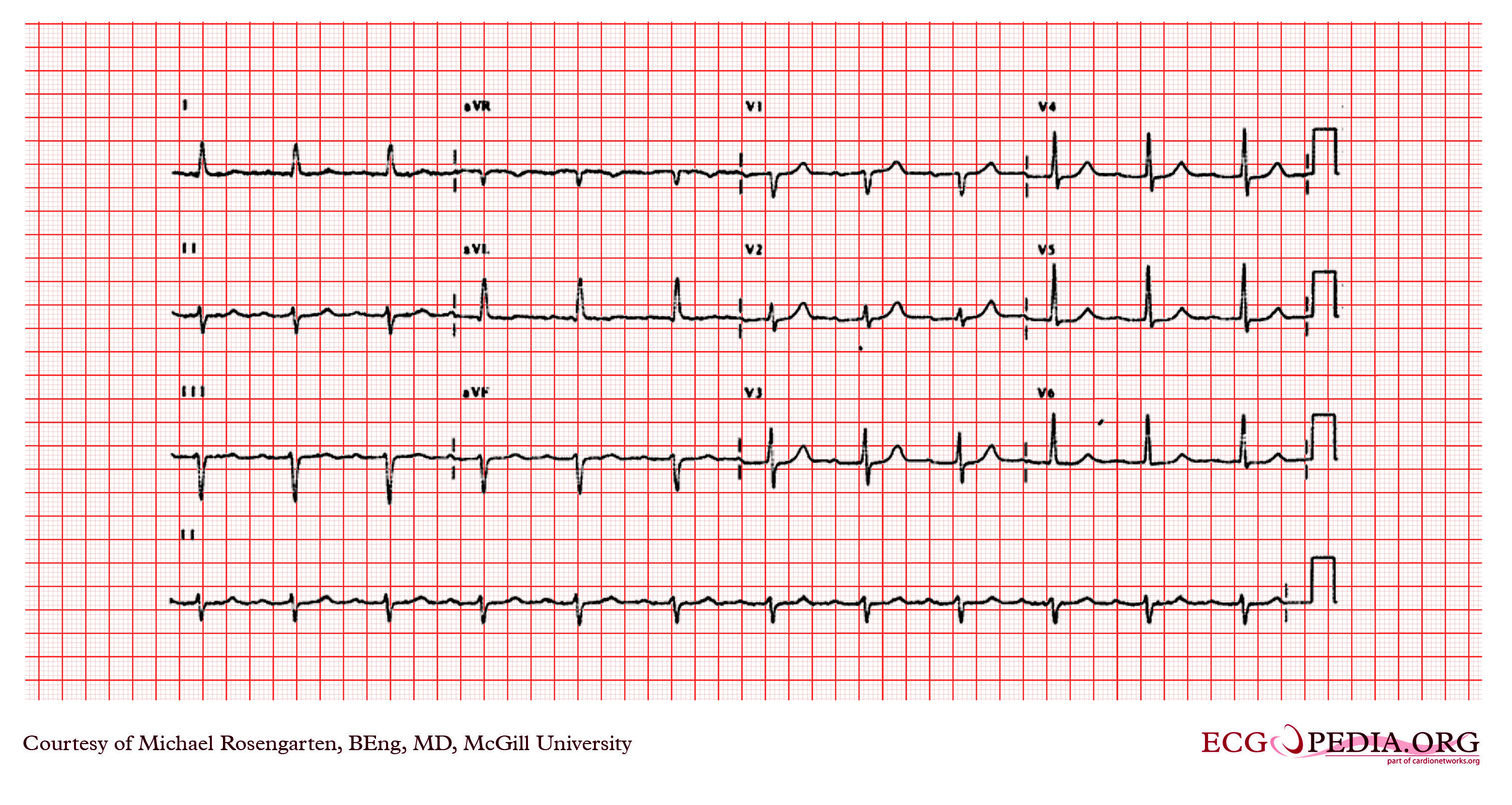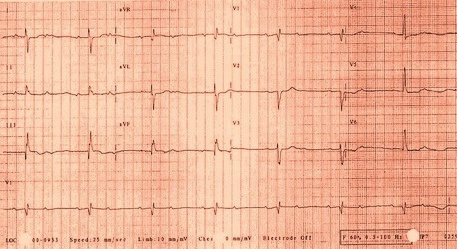Atrioventricular block electrocardiogram: Difference between revisions
| Line 24: | Line 24: | ||
=====Mobitz II Second degree AV block EKG Examples===== | =====Mobitz II Second degree AV block EKG Examples===== | ||
Shown below is an EKG image of two-to-one AV block, which can represent benign block within the [[AV node]] or disease of the [[His-Purkinje system]]. Certain electrocardiographic features and maneuvers can help in distinguishing where the location of block exists. A [[long PR interval]]with a | Shown below is an EKG image of two-to-one AV block, which can represent benign block within the [[AV node]] or disease of the [[His-Purkinje system]]. Certain electrocardiographic features and maneuvers can help in distinguishing where the location of block exists. A [[PR interval prolonged|long PR interval]]with a narrow QRS suggests an intranodal block. A [[short PR interva]]l with intraventricular conduction delay or bundle branch block suggests disease below the node. Responses to atropine, exercise and carotid sinus massage can be helpful in diagnosis. Atropine will improve AV nodal conduction but will worsen block within diseased His-Purkinje fibers. Exercise has a similar effect, improving conduction in cases where block exists only in the node, but worsening when block is subnodal. Alternatively, [[Carotid Sinus Massage]] will slow conduction when block occurs in the AV node, but will improve conduction in diseased His-Purkinje tissue by allowing for refractoriness to recover. | ||
[[Image:2to1AVBlock1.jpg|500px|center]] | [[Image:2to1AVBlock1.jpg|500px|center]] | ||
---- | ---- | ||
Revision as of 16:22, 23 October 2012
|
Atrioventricular block Microchapters |
|
Diagnosis |
|---|
|
Treatment |
|
Case Studies |
|
Atrioventricular block electrocardiogram On the Web |
|
American Roentgen Ray Society Images of Atrioventricular block electrocardiogram |
|
Risk calculators and risk factors for Atrioventricular block electrocardiogram |
Editor-In-Chief: C. Michael Gibson, M.S., M.D. [1]
Overview
Atrioventricular Block Electrocardiogram
First degree AV block EKG Examples
Shown below is an EKG image showing sinus rhythm with a prolonged PR interval (>200ms.) which is first degree A/V block. There is also a left axis deviation (axis between -30 and -90 degrees) with r waves in the inferior leads. This axis deviation is consistent with a left anterior fasicular block.

Second degree AV block EKG Examples
Mobitz I Second degree AV block EKG Examples
Shown below is an EKG image of ventriculophasic reflex during second degree AV block Mobitz I. The PP interval that follow upon the blocked sinus beat is prolonged.

Shown below are two rhythm strips showing Mobitz I A/V block with a gradual increase in the PR interval before the dropped p wave. Note the 2:1 block in the lower strip, and that one can not use this to determine if the block is Mobitz I or II as more than one conducted P wave is required to do this.

Mobitz II Second degree AV block EKG Examples
Shown below is an EKG image of two-to-one AV block, which can represent benign block within the AV node or disease of the His-Purkinje system. Certain electrocardiographic features and maneuvers can help in distinguishing where the location of block exists. A long PR intervalwith a narrow QRS suggests an intranodal block. A short PR interval with intraventricular conduction delay or bundle branch block suggests disease below the node. Responses to atropine, exercise and carotid sinus massage can be helpful in diagnosis. Atropine will improve AV nodal conduction but will worsen block within diseased His-Purkinje fibers. Exercise has a similar effect, improving conduction in cases where block exists only in the node, but worsening when block is subnodal. Alternatively, Carotid Sinus Massage will slow conduction when block occurs in the AV node, but will improve conduction in diseased His-Purkinje tissue by allowing for refractoriness to recover.

Third degree AV block EKG Examples
Shown below is an EKG image of third degree AV block. AV dissociation is present: there is no relation between p-waves and the (nodal) QRS complexes.

Sources
Copyleft images obtained courtesy of ECGpedia, http://en.ecgpedia.org/index.php?title=Special:NewFiles&offset=&limit=500